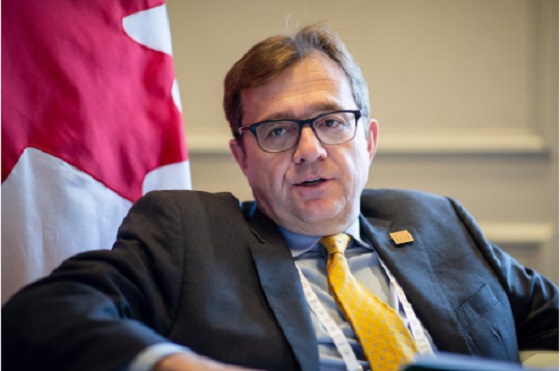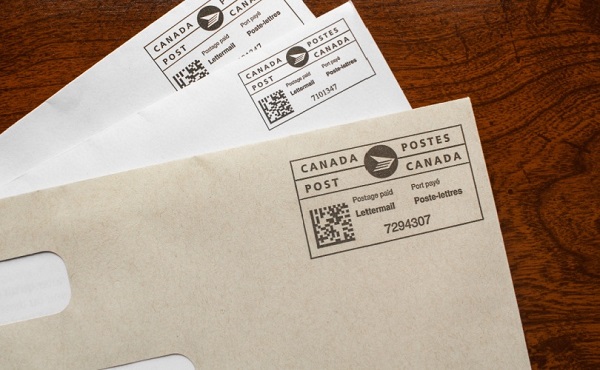Energy
LATE TO THE PARTY: Liberal Resource Minister Minister Suddenly Discovers Canada Needs East-West Pipeline

From Energy Now
By Jim Warren
On Thursday, February 6 federal energy and natural resources Minister Jonathan Wilkinson told reporters about a brilliant idea he’d come up with. He said Canada should think about building an east-west oil pipeline. He claimed doing so could provide Ontario, Quebec and parts further east greater security of supply.
Furthermore, such a pipeline would eliminate the need to buy tanker loads of oil from places like Saudi Arabia and Nigeria. And what’s more it could provide us with the opportunity to export Canadian oil to countries other than the US.
Talk about being late to the party. It’s as though the Energy East project never made it onto the national agenda.
Wilkinson told reporters how a pipeline like Enbridge’s Line 5 is vulnerable to shut down by US authorities. Line 5 carries oil from the prairies through the northern US Midwest before delivering it to the refinery and petrochemicals facilities at Sarnia, Ontario.
This is not breaking news. The Liberals have been well aware of the threat for years. Michigan governor, Gretchen Whitmer waged a well-publicized multi-year campaign to have Line 5 shut down.
According to a CBC report, Wilkinson said, “successive Canadian governments never really gave it much thought that a lot of the energy the country needs to power its economy flows through the U.S.”
That’s a stretch. He apparently doesn’t consider the governments of Alberta and Saskatchewan to be Canadian governments. The real problem is Ottawa wasn’t listening when premiers Notley, Kenney, Smith, Wall and Moe explained the value of an all-Canadian Energy East pipeline. They also had plenty to say about the cancellation of Energy East in 2017 and the role Ottawa played by creating the regulatory approval quagmire that helped kill it.
No less puzzling is that Wilkinson imagines such a pipeline could ever be built under the BANANAs (build absolutely nothing, anywhere, near anything) regulatory barriers implemented by the Liberals which make it next to impossible for anyone to build a new pipeline. When Jason Kenney referred to Bill C-69 as The No More Pipelines Bill he wasn’t just whistling Dixie.
The only major export pipeline to be built in the wake of C-69, was the Trans Mountain expansion (TMX). And it was only completed because the owner, the Government of Canada, was prepared to incur the staggering costs of navigating its own pipeline approval regulations. A pipeline originally budgeted to cost $6.8 billion wound up costing an additional $54 billion. Sane investors simply aren’t prepared to accept that level of unreasonable cost and uncertainty.
A first step in getting new pipelines built would be eliminating Bill C-69 along with Bill C-48, the West coast tanker ban. Wilkinson didn’t touch on those points when telling reporters about his bold new idea.
One has to wonder, after11 years of anti-oil and anti-pipeline policy making, if Wilkinson really means what he’s saying. Has he truly experienced a road to Damascus level conversion due to the threat of US tariffs?
Another plausible explanation for Wilkinson’s call for the resurrection of Energy East is that he’s seen the polling numbers. An Angus Reid poll conducted earlier this month shows 79% of Canadians from across the country support new oil and gas pipelines to tidewater on the east and west coasts. The poll also shows 74% of Quebec respondents now support the idea of building new pipelines to tidewater.

If those numbers hold, Canada’s next government could possibly revisit Energy East. If they succeeded in getting the line built it would represent the most visionary nation building project since the building of the trans-continental railway.
No less surprising is, despite the rise in public support for pipelines, Quebec Premier Francois Legault says he won’t accept a new oil pipeline in his province. Legault is out of step with Quebec opinion on more issues than pipelines. The separatist Parti Quebecois is currently leading Legault’s Coalition Avenir Quebec by 10 points in party preference polls. This is not to say the PQ is any more pipeline friendly.
After11 years of Liberal anti-oil and anti-pipeline policy making, Wilkinson is finally on the right side of the Energy East idea. Some might say better late than never—better to change one’s mind than to continue being wrong. Others will say it is a flip flop of epic proportions and questionable sincerity. Skeptical pundits will question whether Wilkinson’s new found fondness for pipelines is any more credible than Mark Carney’s pledge to get rid of the carbon tax.
Wilkinson is a bright man, so it is possible he has believed Energy East was a good idea for some time. Too bad he didn’t tell us sooner. He waited too long to come clean to expect electoral redemption.
Energy
Could the G7 Summit in Alberta be a historic moment for Canadian energy?

From Resource Works
Canada can be the democratic world’s top energy supplier, and the G7 Summit in Alberta is the perfect time to commit to that.
Canada is at the crossroads of opportunity as the leaders of the G7 convene in Kananaskis, Alberta.
An Ipsos poll has named Canada the top preferred oil supplier among G7 countries for the second time since 2023. No less than 68 percent of G7 respondents declared that Canada was among their top three choices to supply oil.
This should be yet another motivator for Canada to solidify itself as a key player in energy security and economic stability among the democratic nations.
The timing and location of this year’s G7 summit shows how important Canada can be to the world. Alberta, Canada’s energy heartland, is the source of nearly all of the country’s oil, and the provincial government wants more of it to reach global markets.
Those geopolitical anxieties caused by Russia’s invasion of Ukraine in 2022 have not disappeared, and Canada’s allies and partners like the European Union (EU), Japan, South Korea, and India are looking for a reliable and responsible partner to supply them with energy, and we are the best and most obvious choice.
Willing partners are easy to find overseas, but the other provinces and the federal government need to become equally enthusiastic first.
There is more to this than mere symbolism. Canada embracing its position as the most desirable supplier of oil makes complete sense.
In 2023, Ipsos found that Canada’s political stability, comprehensive environmental rules, and strong regulatory frameworks are why it ranked first among preferred oil suppliers. Norway is another popular option, but Canada has the advantage of better market access to the United States and the Asia-Pacific, along with established infrastructure and an open government.
It all combines to create a distinct advantage for Canada in the world of trade.
The US has slid as a popular oil supplier, to Canada’s advantage, and we need to capitalize on that more than ever.
As Russia’s bloody, disruptive war with Ukraine continues to drag on, the EU still needs sources of alternative energy to make a clean break with Moscow. Russia had previously served as the bloc’s effective gas station, albeit one armed with nuclear weapons.
G7 member states like Britain and the EU are looking to slap even stricter limits on Russian energy exports that go beyond what is already in place. Whatever Russia has to lose is Canada’s to gain.
Canada began to enlarge its export capacity last year with the completion of the twinning of Trans Mountain pipeline (TMX), enabling Canada to double the amount of oil it can pipe to Pacific markets. Shipping larger amounts of Canadian energy to partners in Japan, India, South Korea, and others has never been easier.
It was a monumental example of how investing in the right sorts of infrastructure can improve economic security, both nationally and internationally. Internally, developing the oil industry is a long term goal of First Nations leaders and communities.
The myth of First Nations opposing the expansion of oil and gas is one that needs to die. The Indian Resource Council, which represents over 130 First Nations, has repeatedly championed the responsible development of natural resources as a means of fostering economic independence and community renewal.
Many First Nations and other Indigenous groups have invested heavily into pipelines, production sites and storage facilities, and want to expand it further. In terms of pure economic value, there is not another industry that has created more wealth in Indigenous communities across Western Canada.
Complacency from the federal government and other authorities at this time could not be timed more poorly as the G7 Summit comes to Alberta. When the gathering ends on June 17, we should hope that it was a turning point where Canada made a direct and clear commitment to modernizing and expanding its oil and gas sector.
Our role in the world can be that of the great democratic alternative to Russia when it comes to supplying energy and other resources. Alberta knows it, as do our allies and Indigenous people across Canada.
Ottawa should listen. It is time to realize our potential to be an even greater energy superpower.
Through that, we can reduce the power of authoritarian, hostile regimes in the world by building a stronger, more unified Canada.
Alberta
Alberta’s grand bargain with Canada includes a new pipeline to Prince Rupert

From Resource Now
Alberta renews call for West Coast oil pipeline amid shifting federal, geopolitical dynamics.
Just six months ago, talk of resurrecting some version of the Northern Gateway pipeline would have been unthinkable. But with the election of Donald Trump in the U.S. and Mark Carney in Canada, it’s now thinkable.
In fact, Alberta Premier Danielle Smith seems to be making Northern Gateway 2.0 a top priority and a condition for Alberta staying within the Canadian confederation and supporting Mark Carney’s vision of making Canada an Energy superpower. Thanks to Donald Trump threatening Canadian sovereignty and its economy, there has been a noticeable zeitgeist shift in Canada. There is growing support for the idea of leveraging Canada’s natural resources and diversifying export markets to make it less vulnerable to an unpredictable southern neighbour.
“I think the world has changed dramatically since Donald Trump got elected in November,” Smith said at a keynote address Wednesday at the Global Energy Show Canada in Calgary. “I think that’s changed the national conversation.” Smith said she has been encouraged by the tack Carney has taken since being elected Prime Minister, and hopes to see real action from Ottawa in the coming months to address what Smith said is serious encumbrances to Alberta’s oil sector, including Bill C-69, an oil and gas emissions cap and a West Coast tanker oil ban. “I’m going to give him some time to work with us and I’m going to be optimistic,” Smith said. Removing the West Coast moratorium on oil tankers would be the first step needed to building a new oil pipeline line from Alberta to Prince Rupert. “We cannot build a pipeline to the west coast if there is a tanker ban,” Smith said. The next step would be getting First Nations on board. “Indigenous peoples have been shut out of the energy economy for generations, and we are now putting them at the heart of it,” Smith said.
Alberta currently produces about 4.3 million barrels of oil per day. Had the Northern Gateway, Keystone XL and Energy East pipelines been built, Alberta could now be producing and exporting an additional 2.5 million barrels of oil per day. The original Northern Gateway Pipeline — killed outright by the Justin Trudeau government — would have terminated in Kitimat. Smith is now talking about a pipeline that would terminate in Prince Rupert. This may obviate some of the concerns that Kitimat posed with oil tankers negotiating Douglas Channel, and their potential impacts on the marine environment.
One of the biggest hurdles to a pipeline to Prince Rupert may be B.C. Premier David Eby. The B.C. NDP government has a history of opposing oil pipelines with tooth and nail. Asked in a fireside chat by Peter Mansbridge how she would get around the B.C. problem, Smith confidently said: “I’ll convince David Eby.”
“I’m sensitive to the issues that were raised before,” she added. One of those concerns was emissions. But the Alberta government and oil industry has struck a grand bargain with Ottawa: pipelines for emissions abatement through carbon capture and storage.
The industry and government propose multi-billion investments in CCUS. The Pathways Alliance project alone represents an investment of $10 to $20 billion. Smith noted that there is no economic value in pumping CO2 underground. It only becomes economically viable if the tradeoff is greater production and export capacity for Alberta oil. “If you couple it with a million-barrel-per-day pipeline, well that allows you $20 billion worth of revenue year after year,” she said. “All of a sudden a $20 billion cost to have to decarbonize, it looks a lot more attractive when you have a new source of revenue.” When asked about the Prince Rupert pipeline proposal, Eby has responded that there is currently no proponent, and that it is therefore a bridge to cross when there is actually a proposal. “I think what I’ve heard Premier Eby say is that there is no project and no proponent,” Smith said. “Well, that’s my job. There will be soon. “We’re working very hard on being able to get industry players to realize this time may be different.” “We’re working on getting a proponent and route.”
At a number of sessions during the conference, Mansbridge has repeatedly asked speakers about the Alberta secession movement, and whether it might scare off investment capital. Alberta has been using the threat of secession as a threat if Ottawa does not address some of the province’s long-standing grievances. Smith said she hopes Carney takes it seriously. “I hope the prime minister doesn’t want to test it,” Smith said during a scrum with reporters. “I take it seriously. I have never seen separatist sentiment be as high as it is now. “I’ve also seen it dissipate when Ottawa addresses the concerns Alberta has.” She added that, if Carney wants a true nation-building project to fast-track, she can’t think of a better one than a new West Coast pipeline. “I can’t imagine that there will be another project on the national list that will generate as much revenue, as much GDP, as many high paying jobs as a bitumen pipeline to the coast.”
-

 Business19 hours ago
Business19 hours agoCarney’s European pivot could quietly reshape Canada’s sovereignty
-

 Crime1 day ago
Crime1 day agoManhunt on for suspect in shooting deaths of Minnesota House speaker, husband
-

 Alberta19 hours ago
Alberta19 hours agoAlberta’s grand bargain with Canada includes a new pipeline to Prince Rupert
-

 conflict5 hours ago
conflict5 hours ago“Evacuate”: Netanyahu Warns Tehran as Israel Expands Strikes on Iran’s Military Command
-

 Bruce Dowbiggin4 hours ago
Bruce Dowbiggin4 hours agoWOKE NBA Stars Seems Natural For CDN Advertisers. Why Won’t They Bite?
-

 Energy4 hours ago
Energy4 hours agoCould the G7 Summit in Alberta be a historic moment for Canadian energy?
-

 Crime4 hours ago
Crime4 hours agoMinnesota shooter arrested after 48-hour manhunt
-

 Aristotle Foundation2 hours ago
Aristotle Foundation2 hours agoThe Canadian Medical Association’s inexplicable stance on pediatric gender medicine






